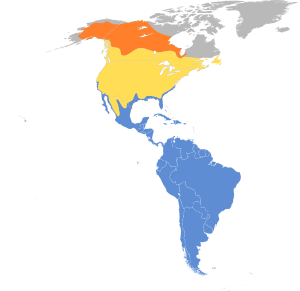Lesser yellowlegs facts for kids
Quick facts for kids Lesser yellowlegs |
|
|---|---|
 |
|
| Conservation status | |
| Scientific classification | |
 |
|
| Synonyms | |
|
Totanus flavipes |
The lesser yellowlegs (Tringa flavipes) is a medium-sized shorebird. It's known for its bright yellow legs! The first part of its scientific name, Tringa, comes from an old Greek word for a wading bird. The second part, flavipes, is from Latin words meaning "yellow" and "foot."
Contents
About the Lesser Yellowlegs
This bird looks a lot like the greater yellowlegs, which is a bit bigger. Even though they look similar, the lesser yellowlegs is actually more closely related to the much larger willet. Scientists figure out these family connections by looking at things like the patterns on their feathers.
What Does It Look Like?
The lesser yellowlegs is a medium-sized shorebird. Its most noticeable feature is its bright yellow legs!
Key Features
Compared to the greater yellowlegs, the lesser yellowlegs has a shorter bill. Its bill is usually about the same length as its head. It is also thin, straight, and completely dark. The feathers on its chest have streaks. Its sides have fine, short bar-like markings.
Size and Weight
Here are some typical measurements for a lesser yellowlegs:
- Length: 9.1 to 10.6 inches (23 to 27 cm)
- Weight: 2.8 to 3.2 ounces (79.5 to 90.9 g)
- Wingspan: 23.2 to 25.2 inches (59 to 64 cm)
Reproduction
Lesser yellowlegs build their nests in clearings near ponds. These areas are usually found in the boreal forest region. This forest stretches from Alaska all the way to Quebec in Canada. They make their nests on the ground. They often choose open, dry spots for their nests.
Migration
These birds are great travelers! They migrate south for the winter. They fly to places like the Gulf coast of the United States, the Caribbean, and even further south into South America. Sometimes, a few lesser yellowlegs fly off course. They can be seen in western Europe. In Great Britain, about five of these birds arrive each year. Most arrive between August and October. Occasionally, one might even stay for the whole winter.
What Do They Eat?
Lesser yellowlegs find their food in shallow water. They sometimes use their bill to stir up the water. This helps them find hidden snacks! They mainly eat insects, small fish, and tiny crustaceans.
Their Call
The call of the lesser yellowlegs is softer than the call of the greater yellowlegs.
Images for kids
See also
 In Spanish: Archibebe patigualdo chico para niños
In Spanish: Archibebe patigualdo chico para niños




